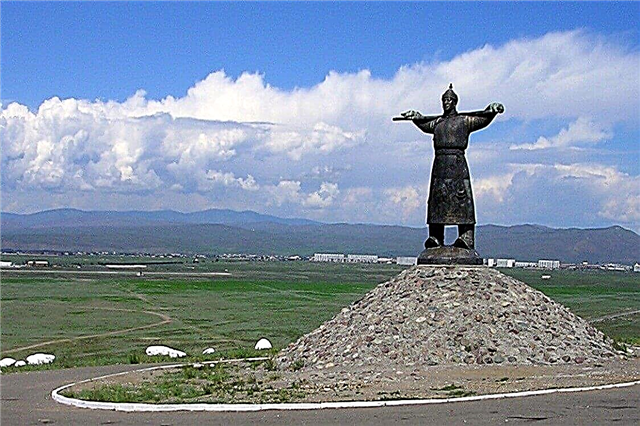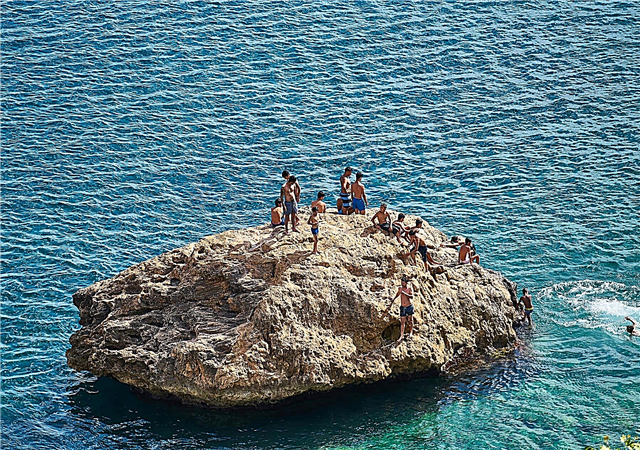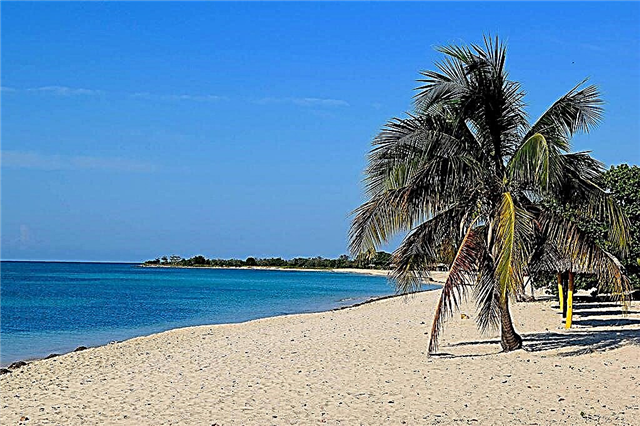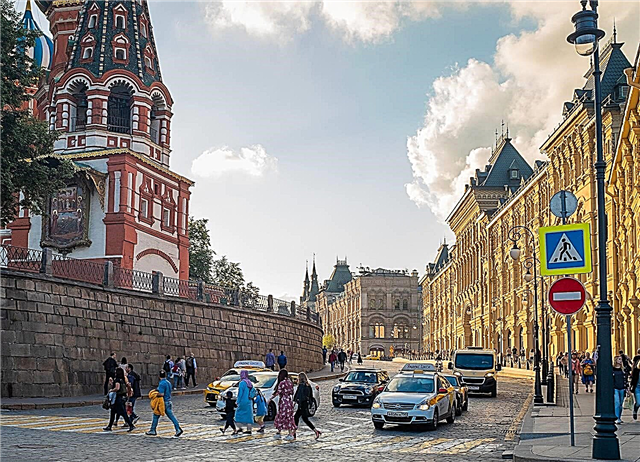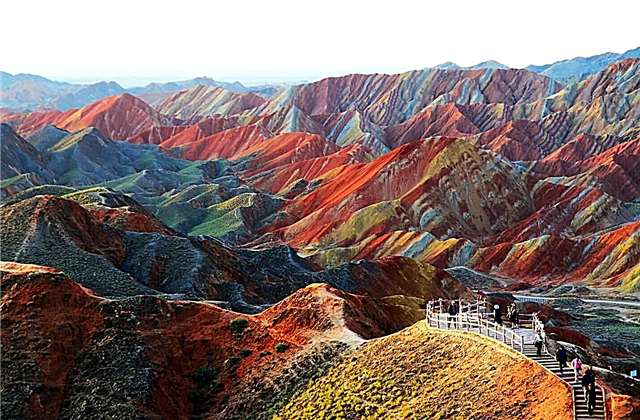National parks in China are somewhat different from similar territories in many other countries. For the most part, they are based around one particular landmark, but at the same time they include many different attractions. Conservation of nature here goes hand in hand with religious and historical heritage.
One of the tourism destinations is the sacred mountains of China. Legends from different denominations are associated with them, so you can find nearby pilgrims professing both Taoism and Buddhism, and sometimes Confucianism. The infrastructure in almost all national parks is at a high level. Tourist groups come to iconic places from all cities of the country, making stops along the way and getting to know even less popular attractions.
Reserves and national parks in China
The most famous and beautiful - a list of the best. Photos with names and descriptions!
Zhangjiajie
The national park in this picturesque mountain-forest area was founded in 1982. Became the first in the country, protected by UNESCO. Located in the Hunan region on an area of almost 48 thousand hectares. The most remarkable natural objects are pillars-peaks, there are more than 3 thousand of them. One of the mountains is named after the movie "Avatar". In the immediate vicinity there are hotels and cafes, a free bus and cable car are at the disposal of tourists.

Mount Huashan
Located in Shaanxi Province, it is one of the sacred mountains of Taoism. It has 5 peaks that resemble tulip petals. The absolute height is 2.1 thousand meters. A special regime for the protection of nature has been in effect since 1998. Tourists are attracted by both ancient temples (some have been converted and do not function) and extreme climbing routes. For those who value comfort and safety, there is a cable car.

Badalin
The territory of the national park (65 hectares) belongs to the suburbs of Beijing. The name translates as "8 mountain ranges". It is believed that the section of the Great Wall of China passing here is the most beautiful and best preserved. In winter, a nearby ski resort begins to operate, and in the fall, there is a festival of red leaves. Another attraction is the Green Dragon Alley.

Tombs of the Ming Dynasty emperors
Frequent visits to this UNESCO World Heritage Site are part of an organized excursion to the Great Wall of China. The tombs are located just halfway from Beijing to the most popular national landmark. The complex of mausoleums was built in the 15th-17th centuries. The tombs were built according to all the rules of feng shui. In the XX century, they were studied in detail, and since then they have been mothballed.

Jiuzhaigou
The national park in Sichuan province was founded in 1982, in 1992 it was included in the list of UNESCO World Heritage Sites, and after another 5 years it became a biosphere reserve. The area is 72 thousand hectares. Its name translates as "the valley of nine villages". All of them are inhabited by Tibetans and Qiang people. Notable objects: multi-colored lakes (Changhai, Sleeping Dragon, Five Flowers, Herbal, etc.), multi-level waterfalls.

"Mountain refuge from the summer heat"
The Qing Dynasty Summer Manor in Hebei Province is located on a hill. It was built throughout almost the entire 18th century. UNESCO World Heritage Site since 1994. On an area of 560 hectares are located: palaces for receptions, ceremonial buildings, private chambers, a vast garden. One of the buildings houses a full-fledged museum. Around, on the slopes - a lush forest, Chengde city buildings, temples.

Huangoshu waterfall
The national park of the same name is located in the Guizhou province. Mountains occupy 90% of the territory. It is referred to as "Eastern Switzerland". Huangoshu is 81 meters wide and 74 meters high. During the rainy season (from May to October), the strength of the flow increases significantly. Together with the nearby 18 waterfalls, they form the largest group of waterfalls on Earth. Other natural features of the park are Tianxing Karst Cave and Stone Forest.

Lake Kukunor
The protected area belongs to the lands of Qinghai province. The area is 420 thousand hectares, but it is not constant, since during a drought it can significantly decrease. The maximum depth is 38 meters. The translation of the name is "blue lake". The second largest in Asia with the following characteristics: mountainous, closed, salty. It is considered one of the sacred lakes of Tibet; a legend about a spring and Buddha is associated with its appearance.

Huanglong Nature Reserve
Located in Sichuan province. The area is 60 thousand hectares. Since 1992, part of the UNESCO World Heritage Fund. The highest point of the highlands is 5.5 thousand meters, it is always covered with snow. The most notable objects: natural colored pools, travertine terraces, waterfalls, dense forests around. Floors have been laid everywhere for the convenience of tourists and to restrict the passage of people into the protected areas.

Mount Wutaishan
Location - Shanxi province. One of the sacred mountains of Buddhism and Taoism. The absolute height is more than 3 thousand meters, the relative height is almost 1.8 thousand meters. Attractions: dozens of temples and monasteries, as well as objects of wooden architecture dating from the 7th-9th centuries. Since 2009 in the UNESCO World Heritage List. It is better to visit the mountain in summer, it is fresh and cool here.

Putoshan Island
The area of the protected area in Zhejiang province is about 1.2 thousand hectares. Tourist places: Buddhist temples and pagodas of different centuries built, starting from the XI century, a statue of Guanyin 33 meters high - a goddess revered in almost all Chinese confessions, Mount Putuo, well-equipped beaches, camphor trees. Water transport runs regularly, delivering tourists to the island.

Jiuhuashan
One of the sacred mountains of Chinese Buddhism is located in Anhui province. The absolute height is 1.3 thousand meters. The mountain system includes up to 100 peaks. There are about the same number of temples in the area. Many legends are associated with the reserved lands, including about the monk Kim Qiao Jue, who lived here for more than half a century, and after his death his body remained unchanged. This attracts pilgrims.

Lake Xihu
Located in the heart of Hangzhou city. It is freshwater and has an area of 650 hectares. In 2001 it was included in the UNESCO World Heritage List. Attractions - pagoda, temples, including - Linyins, the "Racing Tiger" mineral spring, as well as a tea farm. Since it has the status of a reserve of international importance, there are some restrictions on natural resources.

Emeishan
It is one of the sacred mountains of Chinese Buddhism. Protected by UNESCO since 1996. Belongs to the territory of Sichuan province. The absolute height is more than 3 thousand meters, the relative height is more than 1 thousand meters. The first temple was built here in the 1st century. About 20 temples have survived. They are available for inspection. You can climb both by cable car and along special paths. Attraction nearby - Leshan Big Buddha.

Zhangye Danxia
Gansu National Geological Park is a unique natural phenomenon. Its colorful cliffs and hills are the most scenic area in China. The territory received an unusual color due to the deposits of sandstone and the outcropping of rocks to the surface. The area is 51 thousand hectares. You can visit Zhangye Danxia only as part of organized excursion groups. The best time to visit is summer.

Lake Tianchi (Heavenly Lake of the Tien Shan)
The national park became a UNESCO World Heritage Site in 2013. Located in Xinjiang Uygur Autonomous Region. The park is divided into conventional areas. Tourists often visit its northwestern part with good infrastructure. The lake itself is 3 km long, about 650 meters wide. Next to it, you can spend the night in a Kazakh yurt, as well as buy local food or souvenirs.

Huang Di Mausoleum
The burial place of the Yellow Emperor is the founder of Taoism and the ancestor of all Chinese people. Legend has it that the ruler ascended to heaven after his death, so only his clothes are kept in the mausoleum. The complex is a national state cultural center and was one of the first to be included in the protected list. It is located in Shaanxi province and includes several facilities in addition to the mausoleum and temple.

Shuantai-Hekou Nature Reserve
Occupies an area of 80 thousand hectares of Liaoning province. Founded in 1985. Since it is a national biosphere reserve, some parts of it are closed to the public. Red Beach, on the other hand, is a popular tourist destination. It is named a beach rather conditionally, it is a river delta. It turns red because of the unusual plants of the corresponding color, which tightened everything around.

Longmen cave temples
Dated to around the 7th century. Belongs to the lands of Henan province. The tradition of building cave temples goes back to ancient times, but not many similar objects have survived. This is one of the reasons why the area has become a national park. In the rocks, not only rooms were created, but also something like frescoes, walls were painted and statues of impressive size were installed.

Maijishan
A cave Buddhist monastery around which a national park is formed. Located in Gansu province. Now it is not active and works as a museum. Ancient statues have survived, they are not being restored. The exterior cladding with its frescoes, stairs and windows is also noteworthy. Some of the premises are in a deplorable state, they are mothballed and inaccessible for tourists.

Hukou waterfall
It can be found on the border of Shanxi and Shaanxi provinces. The translation of the name is "the neck of a teapot". Height - 15 meters, width - 20 meters. The best time to visit is in the middle of summer, so as not to fall into the rainy season, but at the same time, the waterfall will not lose its strength yet. Due to the local flora and the refraction of light, the water seems to change color during the fall. The area around Hukou became a national park.

Guilin
The national park is located in Guangxi Zhuang Autonomous Region. The city of the same name and its surroundings are a symbiosis of natural beauties and man-made architectural monuments. The Lijiang River runs through the entire city, which gives the landscapes an additional flavor. The peaks covered with greenery are surrounded by dense buildings. Notable places: Reed Flute Cave, Seven Stars Park, Green Lotus Peak and others.

Mount Taishan
Belongs to the protected lands of Shandong province. Height - 1.5 thousand meters. This peak is named after the Jade Emperor. You can use the elevator to get to the top, but most people opt for the stairs that have been laid there, although the path will be long and tiring, but the views are worth it. Nearby there are about 20 temples, hundreds of ruins, and on the rocks there are many inscriptions and drawings.

Huangshan
The National Park, together with the Zhangjiajie Nature Reserve, divides one mountain range. Located in Anhui province. The peculiarity of the area is the old pines with bizarre shapes. The total number of steps created for climbing the mountains is more than 40 thousand. Some of the spades have separate names, such as Fairy Bridge or Master's Brushes. Included in the list of UNESCO World Heritage Sites.

Tianzhushan nature reserve
Located in Anhui province. The area is over 8 thousand hectares. The absolute height of the mountain of the same name is 1.7 thousand meters. The cable car is less in demand than paved decks, walkways and stairs. This is due to the fact that on the way to the top you can meet small sights (temples, ruins, natural beauty), which cannot be seen from the trailer. Pilgrims prefer hiking trails for religious reasons.

Hengshan (Shanxi)
The mountain and the national park around it belong to the Shanxi province. Sometimes referred to as the North Hengshan. The absolute height is just over 2 thousand meters. One of the sacred mountains of Taoism. The main attraction is Xuankong-si - a temple complex that united three religions: Taoism, Buddhism and Confucianism. It is called hanging, as the buildings are attached or embedded in the rocks.

Hengshan (Hunan)
The national park and the mountain of the same name are located in the Hunan province. The area attracts pilgrims (Taoist and Buddhist temples and monasteries). Part of the territory belongs to the reserve, through which a road has been laid. Sightseeing: Shuilian Cave, Dai Monument, Huixian Narrow Stone Bridge and others. A wide staircase leads to the top. There is a cable car that covers a third of the ascent.

Tianmenshan
It is a state forest park. The hills and cliffs of this part of the Hunan province are covered with dense vegetation. The Heavenly Gate is the tallest cave in the world. A solid staircase of 999 steps has been laid to it. You can also go down the serpentine road with many turns. Adrenaline lovers will choose the "glass heavenly path" - 60 meters of glass path above the abyss. There is also a cable car.

Laoshan Qingdao
The area of the national park is 30 thousand hectares. Location - southeast of the Shandong Peninsula. Mount Laoshan has a height of over 1.1 thousand meters. There are healing mineral springs at the top. Nearby there is a park complex with palaces, monasteries and pavilions. Further - Beijushuei - an area with waterfalls, ponds, arched bridges, ancient forest, and one of the main attractions - the cave of Buddha Naluoyang.

Wudangshan
The mountain and the national park of the same name are located in Hubei province. The area is about 40 thousand hectares. The area attracts pilgrims, both because of the presence of ancient temples here, and because of the schools of martial arts. The question of the origin of taichi in these parts is controversial. Demonstrations of fighters and festivals are held on holidays. The most famous building is the Forbidden City complex at the top.





